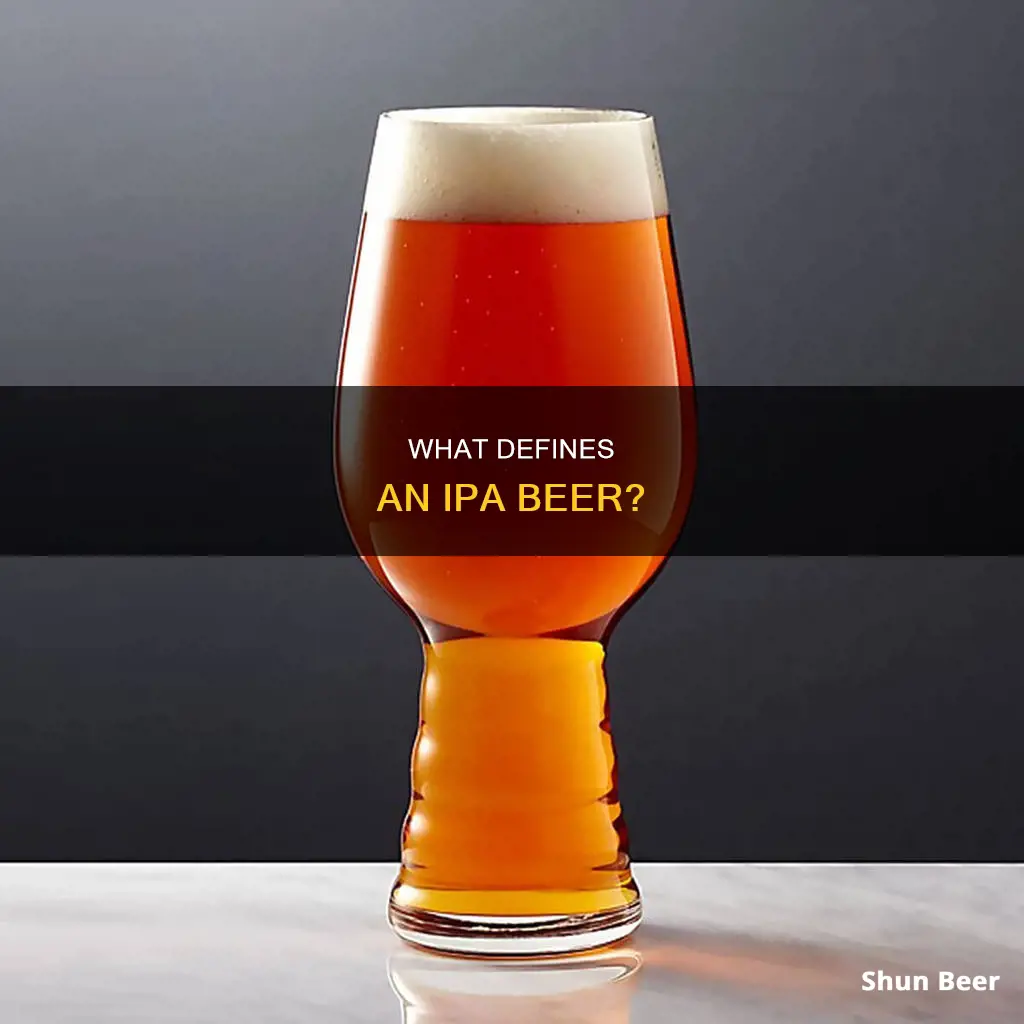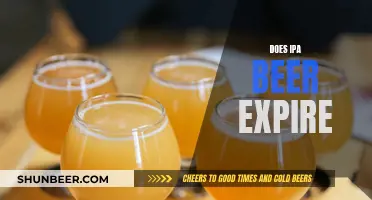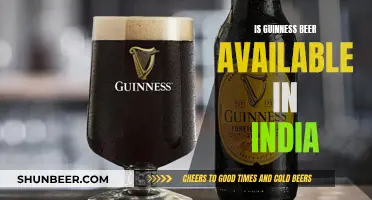
IPAs, or India Pale Ales, are a style of beer that has become increasingly popular in recent years. Characterised by their hoppy aromas and flavours, IPAs can range from bitter to fruity and crisp. While IPAs are often associated with high alcohol content, this is not always the case. The ABV of an IPA can vary depending on the type, with some having a lower alcohol content that makes them easier to drink. The different types of IPAs include West Coast, New England, Session, British, Double or Imperial, and Single-Hopped. So, how do you know if a beer is an IPA? Look out for the distinct hoppy flavours and aromas, and check the ABV to determine the type of IPA you're drinking.
What You'll Learn
- IPAs are India Pale Ales, with a higher hop concentration than regular beers
- The higher the ABV, the stronger the beer. Session IPAs are under 5% ABV, while Double/Imperial IPAs are over 7%
- Hazy IPAs are unfiltered and lower in bitterness
- Dry-hopped IPAs are brewed by steeping hops in fermenting beer, creating a strong aroma
- New England IPAs are hazy, with a fruity flavour and low carbonation

IPAs are India Pale Ales, with a higher hop concentration than regular beers
IPAs, or India Pale Ales, are a style of beer that is known for its strong hoppy flavours and aromas. The name dates back to the time of the British Empire, when sailors needed a beer that could withstand the long journey from Britain to India. Brewers added extra hops to the beer as a preservative, and the India Pale Ale was born.
Today, IPAs are known for their bold, bitter, and fruity flavours, with a higher concentration of hops than regular beers. The higher hop content also often results in a higher alcohol content, although this is not always the case. The typical alcohol content of an IPA can range from 5% to 7% or more, depending on the specific type of IPA.
There are several popular variations of IPAs, including the West Coast IPA, which is known for its hoppy, fruity, and crisp taste, and the New England IPA, which is hazy and has a lower bitterness level. Another variation is the Session IPA, which has a lower alcohol content, typically below 5% ABV, making it perfect for those who want the flavour of an IPA without the higher alcohol content.
The Double or Imperial IPA is another popular variation, with twice the amount of hops as a standard IPA, resulting in a stronger, hoppier flavour. These IPAs often have a higher alcohol content as well, usually 7% or more.
IPAs have become incredibly popular in recent years, with craft brewers embracing the style and creating a wide range of flavours and variations. The strong flavours of IPAs, particularly the bold and bitter notes, have made them a favourite among beer enthusiasts.
Guinness Beer Quality: Is It Worth the Hype?
You may want to see also

The higher the ABV, the stronger the beer. Session IPAs are under 5% ABV, while Double/Imperial IPAs are over 7%
The ABV (alcohol by volume) of a beer is a good indicator of how strong it is. The higher the ABV, the stronger the beer.
Session IPAs are a good choice for those who want to enjoy more than one beer in a session without getting too drunk. They have less alcohol content, usually under 5% ABV. Historically, session IPAs were 4% ABV or lower. The lower alcohol content means that session IPAs have a thinner body and can be enjoyed one after the other.
On the other hand, Double or Imperial IPAs are for those who want to get drunk faster. These beers have a higher hop concentration, and to balance the hop flavour, brewers use more malt, resulting in a higher ABV, usually over 7%. Double IPAs and Imperial IPAs are very similar and should be consumed with caution.
The Irish Pride: Guinness Beer's Roots and Heritage
You may want to see also

Hazy IPAs are unfiltered and lower in bitterness
Hazy IPAs, also known as New England IPAs, are characterised by their cloudy, opaque appearance. This distinctive haze is created through extensive dry hopping, as well as the use of oats and wheat in the brewing process. Hazy IPAs are unfiltered, which contributes to their cloudy appearance.
In terms of flavour, Hazy IPAs tend to have lower bitterness compared to other styles of IPAs. They emphasise fruity and juicy notes, often described as "ripe citrus", with less focus on the bitter qualities usually associated with hops. The perceived bitterness of Hazy IPAs is influenced by factors such as alcohol content, malt profile, and residual sugars, resulting in a softer, less bitter taste.
The Beer Judge Certification Program (BJCP) guidelines specify that Hazy IPAs should have a "low to medium-high perceived bitterness", with International Bitterness Units (IBU) ranging from 25 to 60. The Brewers Association (BA) guidelines allow for a similar IBU range of 20 to 50, acknowledging that the measured bitterness may differ significantly from the perceived bitterness.
Hazy IPAs can be brewed across a wide range of ABV levels, from session IPAs with lower alcohol content to stronger double or imperial IPAs. They are known for their full mouthfeel and fruity hop character, making them a popular style within the craft beer world.
Daphne Guinness: Beer Heiress or Just a Coincidence?
You may want to see also

Dry-hopped IPAs are brewed by steeping hops in fermenting beer, creating a strong aroma
India Pale Ales (IPAs) are a style of beer that has become increasingly popular. They are characterised by their hoppy quality, with a strong emphasis on hop flavours and aromas. While IPAs can be bitter, they also explore the world of fruity flavours that can be achieved through hops. One way to create a strong aroma in an IPA is through dry-hopping.
Dry-hopping is a technique used in brewing to add hops late in the brewing process, either during fermentation or conditioning. It is called dry-hopping because the hops are added at a time when you are no longer touching the water or wort, simply tossing the dry hops into a fermenter. The hops used in dry-hopping can come in the form of whole cone hops, pellet hops, or Cryo Hops. Whole cone hops are the rustic option, added as whole flowers, but they are not commonly used in homebrewing as they absorb a higher quantity of beer and dull the aromas extracted from the hop oil. Pellet hops are the most common and affordable form, made by crushing and pressing the whole dried hops into pellets. Cryo Hops are a newer form, made by freezing and pulverising the hops, resulting in a fine powder that packs a lot of aroma and oil.
The purpose of dry-hopping is to capture the aromas and flavours of the hops, creating an extremely strong aroma that amplifies the fruity, piney, or candy-sweet notes of the hops. It makes the beer smell better without adding any bitterness. This is because the alpha acids in hops, which create bitterness, are not converted during the dry-hopping process as it occurs at cooler temperatures. Instead, the hop essential oils are extracted, which contain aroma compounds that supply flavours such as "dank", tropical, vinous, or fruity. These oils are highly volatile and quickly boil off at high temperatures, so they are best extracted at the cooler temperatures of fermentation.
Dry-hopping is a popular technique in brewing IPAs, as it enhances the hoppy character of the beer. It is particularly associated with American IPAs, where the bright hop flavours and aromas have become a quintessentially American attribute. The technique was inspired by the cask-conditioned ales found in English pubs, and American brewers took up dry-hopping with fervour, making it an integral part of the American beer terroir.
The Slow Decline of IPAs: What's Next for Beer?
You may want to see also

New England IPAs are hazy, with a fruity flavour and low carbonation
New England IPAs, also known as NEIPAs, are a style of American IPA. They are unfiltered, giving them a hazy or cloudy appearance, and are heavily dry-hopped. This process adds intense, fruity flavours and aromas, particularly of tropical fruits, to the beer.
The haziness of a New England IPA is caused by a variety of techniques used by brewers to enhance the aromas and create a smooth, creamy mouthfeel, while reducing the harsh bitterness associated with more conventional IPAs. These techniques include using certain yeast strains that leave fruity esters in the beer, as well as suspended matter, which also helps produce the haze.
New England IPAs tend to have lower carbonation than other beers, and are often described as having a "full-bodied wall of rich aromatics". The flavour is hop-heavy, with the fruitier spectrum of hops accentuated by yeast esters that produce sweet undernotes. The types of hops used are commonly associated with ripe or overripe tropical fruits such as passionfruit, guava, papaya, mango, and pineapple, though some brews can have a more citrusy character.
New England IPAs are one of the most popular styles of beer in the world and have become extremely sought-after. They are often described as "juicy", "cloudy", and "lush", and are considered a good option for those who don't usually enjoy IPAs due to their low bitterness and fruity flavours.
Guinness Beer: Organic or Not?
You may want to see also
Frequently asked questions
IPA stands for Indian Pale Ale or India Pale Ale.
IPAs were first brewed in the UK in the 1780s and became popular among British soldiers and administrators serving in India. The beer was brewed with lots of hops to survive long journeys without spoiling.
IPA is a style of beer, which is made with more hops to give it a stronger flavour. There is no standardised threshold for a pale ale to be considered an IPA, it is up to the brewer.
A double IPA is an India Pale Ale but with twice the amount of hops used in standard blends, resulting in a stronger, hoppier flavour.







